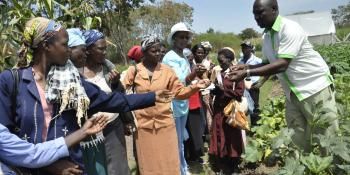Intercropping mango trees benefits farmers in the Albertine Rift

Farmers in Uganda learn about agronomic practices, enabling them to increase productivity and income.
Since the year 2012, the CGIAR Research Program on Climate Change, Agriculture and Food Security has collaborated with Uganda’s National Agricultural Research Organisation (NARO) to help farmers in Hoima respond to climate change and variability in order to reduce periodic hunger, and improve food security and household income. This is achieved through the integration of a science approach based on the CCAFS Climate-Smart Village (CSV) model, focusing on improving local knowledge of climate risks to inform farming decisions.
Starting in 2013, two community-based organizations−Bagonza-Kukora and Kyabigambire Farmers Organisation− were formed in Hoima to empower communities through collective action. NARO’s local research centre called Bulindi Zonal Agricultural Research and Development Institute (Bulindi ZARDI) implements a participatory process with the farmers to identify interventions that respond to climate-related risks. After prioritizing the interventions, Bulindi ZARDI builds the capacity of farmers through training and extension support for improved agroforestry, soil and water management, improved crop production and improved livestock production.
For the last five years, the farmers have been intercropping improved mango fruit trees with food crops such as maize, sorghum, cassava, sweet potatoes, nitrogen fixing legumes (beans and groundnuts) and indigenous vegetables. Mangoes are among the five popular fresh fruits in Uganda, and the trees are planted across contours and also on terrace ridges to conserve soil by reducing erosion.
In 2017, over 50 farmers in Hoima got a threefold mango yield from improved mango trees. The local mango varieties yield about 200 fruits per year, but the improved varieties gave an average of 600 fruits. Champion farmer Asiimwe Zainabo explaned how the improved mango varieties impacted his harvest:
The improved mango varieties that I planted in 2013 matured within three years and gave me the first harvest. This is half the time it takes the local varieties on my farm to produce the first fruits. In addition, the bumper harvest from the improved varieties pleasantly surprised me. From my 50 mango trees, I was able to harvest about six tons of fresh fruits that were also bigger, more delicious, and had less fibre compared to the local mango varieties. Those fruits sold fast.”
The improved mango varieties that are planted in Hoima are Boribo, Bire and Tommy Artkins. Farmers are trained on the following agronomic practices:
- Soils and spacing: Mangoes are planted in deep soils with good drainage. The optimum spacing of 8m by 8m giving 144 plants per hectare.
- Planting: Farmers are advised to plant during the rainy season, in holes which are 0.6m wide and 0.6 m deep.
- Weeding: Regular removal of weeds around the trees and intercrops is needed. At the young stage of the crop, intercropping with lowly growing crops like beans, and groundnuts is encouraged.
- Fertilizer requirement: Applying manure at least once a year provides nutrients for faster growth hence building productive capacity, and helps to fend off some diseases.
- Mulching: Farmers are advised to mulch the plants immediately after transplanting to conserve soil moisture, improve fertility and health of the soil, and reduce weed growth.
- Watering: Young trees should be watered at least once a week during dry periods. It is advisable to give water during flowering to avoid flower abortion. Similarly, watering after the fruit sets reduces fruit abortion and increases fruit size.
- Pruning: This is done at a young stage, when the trees are at a height of 0.5m-1m above the ground. Pruning off the excessive shaded branches removes leaves that do not photosynthesize.
- Harvesting: Mature fruits with smooth undamaged skin should be picked.
- Production: Time from flowering to maturity is 100-150 days depending on variety. Under good management, 600 fruits per year can be produced. The yield range is 8-16 ton/ha can be obtained, depending on management, variety, and age of orchard. Improved varieties can weigh from 0.3kg each.
- Pests and diseases: Integrated pest management is emphasized, and biological and chemical methods for disease management taught to farmers.
part of the income from mangoes is channeled into village savings.
The mangoes were collected from individual farmers by transporting agents who delivered them to big local markets in Hoima district headquarters and later to Kampala city. Some of the mangoes end up with processing companies; processing is still low and is mainly limited to extraction of juice, drying, bottling and labeling. As a source of vitamins, mangoes have contributed to the health of communities in Hoima. Part of the income from mangoes is channeled into village savings through table banking and loaning. Farmers invest their income from the mangoes in other agricultural activities such as horticulture, purchasing food, paying school fees, and off-farm activities such as small businesses.
Growing mangoes as part of agroforestry offers both climate change mitigation and adaptation benefits to Hoima farmers. This is because a high amount of biomass carbon is sequestered by mango trees on farms. Increasing biomass carbon on agricultural lands through agroforestry may also improve biodiversity, water quality, and, in some cases, hydrological cycles. Trees regulate moisture – moderating drought or heavy precipitation – and soil temperature. Mango trees are a critical component of climate-smart agriculture.
Read more:
- Recha J, Kimeli P, Atakos V, Radeny M, Mungai C. 2017. Stories of Success: Climate-Smart Villages in East Africa. Wageningen, Netherlands: CGIAR Research Program on Climate Change, Agriculture and Food Security (CCAFS).
- Recha J, Radeny M, Kimeli P, Hafashimana D, Masanyu J, Ssekiwoko F, Odongo W. 2016. Progress in achieving household food security in climate-smart villages in the Albertine Rift, western Uganda. CCAFS Info Note. Copenhagen, Denmark: CGIAR Research Program on Climate Change, Agriculture and Food Security (CCAFS).
John Recha is a Post Doctoral Fellow with CCAFS East Africa.



